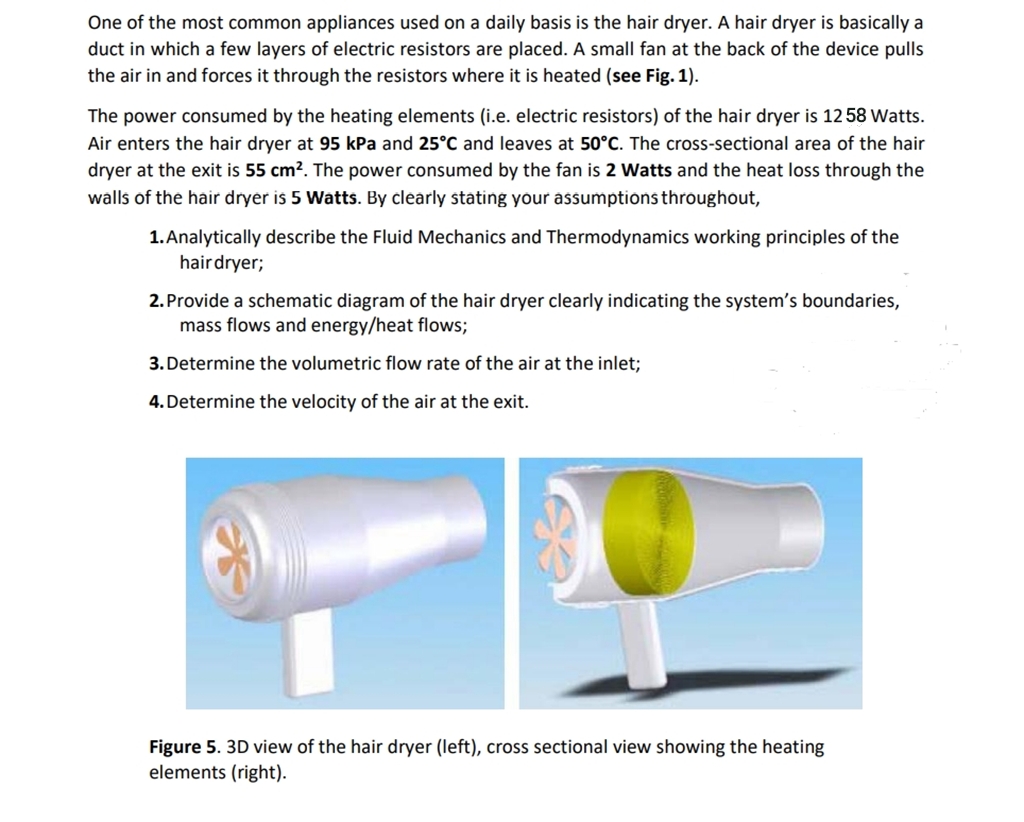One of the most common appliances used on a daily basis is the hair dryer. A hair dryer is basically a duct in which a few layers of electric resistors are placed. A small fan at the back of the device pulls the air in and forces it through the resistors where it is heated (see Fig. 1). The power consumed by the heating elements (i.e. electric resistors) of the hair dryer is 12 58 Watts. Air enters the hair dryer at 95 kPa and 25°C and leaves at 50°C. The cross-sectional area of the hair dryer at the exit is 55 cm². The power consumed by the fan is 2 Watts and the heat loss through the walls of the hair dryer is 5 Watts. By clearly stating your assumptions throughout, 1.Analytically describe the Fluid Mechanics and Thermodynamics working principles of the hairdryer; 2. Provide a schematic diagram of the hair dryer clearly indicating the system's boundaries, mass flows and energy/heat flows; 3. Determine the volumetric flow rate of the air at the inlet; 4. Determine the velocity of the air at the exit.
One of the most common appliances used on a daily basis is the hair dryer. A hair dryer is basically a duct in which a few layers of electric resistors are placed. A small fan at the back of the device pulls the air in and forces it through the resistors where it is heated (see Fig. 1). The power consumed by the heating elements (i.e. electric resistors) of the hair dryer is 12 58 Watts. Air enters the hair dryer at 95 kPa and 25°C and leaves at 50°C. The cross-sectional area of the hair dryer at the exit is 55 cm². The power consumed by the fan is 2 Watts and the heat loss through the walls of the hair dryer is 5 Watts. By clearly stating your assumptions throughout, 1.Analytically describe the Fluid Mechanics and Thermodynamics working principles of the hairdryer; 2. Provide a schematic diagram of the hair dryer clearly indicating the system's boundaries, mass flows and energy/heat flows; 3. Determine the volumetric flow rate of the air at the inlet; 4. Determine the velocity of the air at the exit.
Sustainable Energy
2nd Edition
ISBN:9781337551663
Author:DUNLAP, Richard A.
Publisher:DUNLAP, Richard A.
Chapter19: Battery Electric Vehicles (bevs)
Section: Chapter Questions
Problem 8P
Related questions
Question

Transcribed Image Text:One of the most common appliances used on a daily basis is the hair dryer. A hair dryer is basically a
duct in which a few layers of electric resistors are placed. A small fan at the back of the device pulls
the air in and forces it through the resistors where it is heated (see Fig. 1).
The power consumed by the heating elements (i.e. electric resistors) of the hair dryer is 1258 Watts.
Air enters the hair dryer at 95 kPa and 25°C and leaves at 50°C. The cross-sectional area of the hair
dryer at the exit is 55 cm². The power consumed by the fan is 2 Watts and the heat loss through the
walls of the hair dryer is 5 Watts. By clearly stating your assumptions throughout,
1.Analytically describe the Fluid Mechanics and Thermodynamics working principles of the
hairdryer;
2. Provide a schematic diagram of the hair dryer clearly indicating the system's boundaries,
mass flows and energy/heat flows;
3. Determine the volumetric flow rate of the air at the inlet;
4. Determine the velocity of the air at the exit.
Figure 5. 3D view of the hair dryer (left), cross sectional view showing the heating
elements (right).
Expert Solution
This question has been solved!
Explore an expertly crafted, step-by-step solution for a thorough understanding of key concepts.
Step by step
Solved in 2 steps with 2 images

Knowledge Booster
Learn more about
Need a deep-dive on the concept behind this application? Look no further. Learn more about this topic, civil-engineering and related others by exploring similar questions and additional content below.Recommended textbooks for you


Engineering Fundamentals: An Introduction to Engi…
Civil Engineering
ISBN:
9781305084766
Author:
Saeed Moaveni
Publisher:
Cengage Learning


Engineering Fundamentals: An Introduction to Engi…
Civil Engineering
ISBN:
9781305084766
Author:
Saeed Moaveni
Publisher:
Cengage Learning